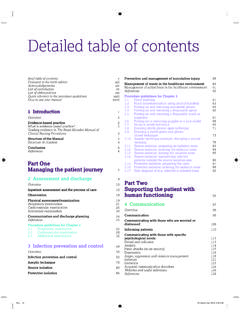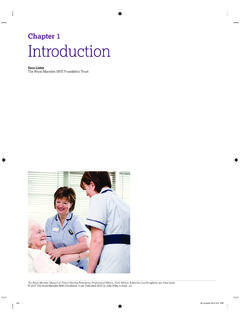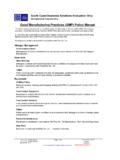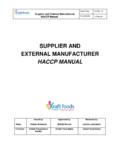Transcription of Managing the patient journey - Royal Marsden …
1 C02 7 8 December 2014 9:56 PM2 Assessment and discharge 93 Infection prevention and control 37 Managing the patient journeyPart Onec02 9 8 December 2014 9:56 PMThe Royal Marsden Manual of Clinical Nursing Procedures: Student Edition, Ninth Edition. Edited by Lisa Dougherty, Sara Lister and Alexandra West-Oram 2015 The Royal Marsden NHS Foundation Trust. Published 2015 by John Wiley & Sons, reading this chapter and undertaking the learning activities within it, you should be able to: 1 Demonstrate a critical understanding of the principles and structure of nursing assessment, so that such frameworks and tools can be used to identify patient problems/nursing diagnoses and monitor the effectiveness of care. 2 Construct a comprehensive nursing care plan for a patient that includes clear identification of the patient s problems, measurable outcomes and realistic nursing interventions.
2 3 Identify the key considerations when planning a discharge for a patient from hospital to the community to ensure the patient receives safe and effective ongoing and dischargeTHE Royal Marsden MANUAL OF CLINICAL NURSING PROCEDURES10c02 10 8 December 2014 9:56 PMOverviewThis chapter will give an overview of a patient s care from assessment through to forms an integral part of patient care and is considered to be the first step in the process of individualized nursing care. It provides information that is critical to the development of a plan of action that enhances personal health decreases the potential for, or the severity of, chronic conditions and helps the individual to gain control over their health through self-care (RCN 2004).
3 Early and continued assessments are vital to the success of the management of patient care. It is critical that nurses have the ability to assess patients and document their findings in a systematic planning is key to ensuring that patients return to the community with the appropriate care to support them and their carers at home. The process can also reduce hospital length of stay and unplanned readmission to hospital, and improve the co-ordination of services following discharge from hospital (Shepperd et al. 2013).The nurse s ability to assess the needs of the patient and carer (Atwal 2002) is central to a good assessment and the process of careDefinitionAssessment is the systematic and continuous collection, organization, validation and documentation of information (Berman et al.)
4 2010). It is a deliberate and interactive process that underpins every aspect of nursing care (Heaven and Maguire 1996). It is the process by which the nurse and patient together identify needs and concerns. It is seen as the cornerstone of individualized care, a way in which the uniqueness of each patient can be recognized and considered in the care process (Holt 1995).RelAteD theoRyPrinciples of assessmentThe purpose of the nursing assessment is to get a complete picture of the patient and how they can be helped. An effective assessment will provide the nurse with information on the patient s background, lifestyle, family history and the presence of illness or injury (Crouch and Meurier 2005).
5 The nursing assessment should focus on the patient s response to a health need rather than disease process and pathology (Wilkinson 2007). The process of assessment requires nurses to make accurate and relevant observations, to gather, validate and organize data and to make judgements to determine care and treatment needs. It should have physical, psychological, spiritual, social and cultural dimensions, and it is vital that these are explored with the person being assessed. The patient s perspective of their level of daily activity functioning (Horton 2002) and their educational needs is essential to help maximize their understanding and self-care abilities (Alfaro-LeFevre 2014). It is only after making observations of the person and involving them in the process that the nurse can validate their perceptions and make appropriate clinical patient assessment is integral to the safety, continuity and quality of patient care, and fulfils the nurse s legal and professional obligations in practice.
6 The main principles of assessment are outlined in Box of assessmentStructuring patient assessment is vital to monitoring the success of care and detecting the emergence of new problems. There are many conceptual frameworks or nursing models, such as Box Principles of assessment1 patient assessment is patient focused, being governed by the notion of an individual s actual, potential and perceived It provides baseline information on which to plan the interventions and outcomes of care to be It facilitates evaluation of the care given and is a dimension of care that influences a patient s outcome and potential It is a dynamic process that starts when problems or symptoms develop, and continues throughout the care process.
7 Accommodating continual changes in the patient s condition and It is essentially an interactive process in which the patient actively Optimal functioning, quality of life and the promotion of independence should be primary The process includes observation, data collection, clinical judgement and validation of Data used for the assessment process are collected from several sources by a variety of methods, depending on the healthcare To be effective, the process must be structured and clearly : Adapted from Alfaro-LeFevre (2014), NMC (2008), Teytelman (2002), White (2003).Roper s Activities of Daily Living (Roper et al. 2000), Orem s self-care model (Orem et al. 2001) or Gordon s Functional Health Patterns Framework (Gordon 1994).
8 There remains, however, much debate about the effectiveness of such models for assessment in practice, some arguing that individualized care can be compromised by fitting patients into a rigid or complex structure (Kearney 2001, McCrae 2012). Nurses therefore need to take a pragmatic approach and utilize assessment frameworks that are appropriate to their particular area of practice. This is particularly relevant in today s rapidly changing healthcare climate where nurses are taking on increasingly advanced roles, working across boundaries and setting up new services to meet patients needs (DH 2006a).Nursing models can serve as a guide to the overall approach to care within a given healthcare environment and therefore provide a focus for the clinical judgements and decision-making processes that result from the process of assessment.
9 During any patient assessment, nurses engage in a series of cognitive, behavioural and practical steps but do not always recognize them as discrete decision-making entities (Ford and McCormack 1999). Nursing models give novice practitioners a structure with which to identify these processes and to reflect on their practice in order to develop the analytical, problem-solving and judgement skills needed to provide an effective patient models have been developed according to different ways of perceiving the main focus of nursing. These include adaptation models ( Roy 1984), self-care models ( Orem et al. 2001) and activities of daily living models ( Murphy et al. 2000). Each model represents a different view of the relationship between four key elements of nursing: health, person, environment and nursing.
10 It is important that the appropriate model is used to ensure that the focus of assessment data collected is effective for particular areas of practice (Alfaro-LeFevre 2014, Murphy et al. 2000). Nurses must also be aware of the rationale for implementing a particular model since the choice will determine the nature of patient care in their day-to-day work. The approach should be sensitive enough ChAPteR 2 AssessMent AnD DisChARge11c02 11 8 December 2014 9:56 PMto discriminate between different clinical needs and flexible enough to be updated on a regular basis (Allen 1998, Smith and Richardson 1996).The framework of choice at the Royal Marsden Hospital is based on Gordon s Functional Health Patterns (Gordon 1994; Box ).








